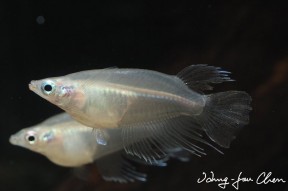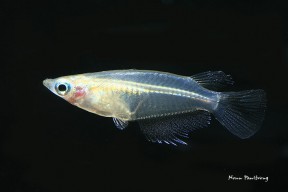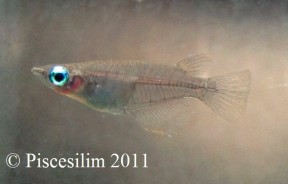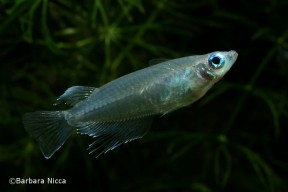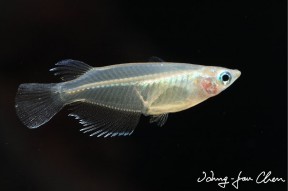Oryzias dancena
Indian Ricefish
SynonymsTop ↑
Cyprinus dancena Hamilton, 1822; Aplocheilus mcclellandi Bleeker, 1854; ? Panchax cyanopthalma Blyth, 1858; ? Panchax argenteus (non Day, 1868)
Etymology
Oryzias: from the Greek ὄρυζα (oryza), meaning ‘rice’, in reference to the tendency of some members of the genus to inhabit rice paddy fields.
dancena:
Classification
Order: Beloniformes Family: Adrianichthyidae
Distribution
Described from ‘the estuary below Calcutta’, which presumably refers to the mouth of the Hooghly River south of Kolkata, West Bengal state, eastern India.
Current knowledge suggests it to be widely-distributed throughout eastern and southern India, Sri Lanka, Bangladesh and Myanmar.
There also exist records from the western slope of the Malay Peninsula including Ranong province in southern (Peninsular) Thailand and Penang state, northern Peninsular Malaysia.
Habitat
Tends to occur in coastal waters but is adaptable and has been collected in a range of habitat-types, from strongly brackish, tidally-influenced mangrove swamps to acidic, freshwater forest streams, major river basins, pools and oxbows.
Maximum Standard Length
25 – 35 mm.
Aquarium SizeTop ↑
An aquarium with base dimensions of 45 ∗ 30 cm or more is recommended for a group.
Maintenance
Best maintained in a heavily planted set-up, ideally with a dark substrate, patches of dense vegetation, and some open areas.
Other décor can consist of twisted roots and pieces of bogwood, while surface vegetation is also appreciated by the fish.
When maintained under such conditions they’re more likely to display their best colours, and planted aquaria also offer fry a more favourable chance of survival alongside the adults.
Water Conditions
Temperature: 23 – 27 °C
pH: 6.5 – 8.5
Hardness: 90 – 447 ppm
Diet
A micropredator feeding on small insects, worms, crustaceans and other zooplankton in nature.
In the aquarium it will accept dried foods of a suitable size but should be offered daily meals of small live and frozen fare such as Daphnia, Artemia, chopped bloodworm, etc., along with good quality, suitably-sized flakes and granules.
Behaviour and CompatibilityTop ↑
Generally peaceful but doesn’t make an ideal addition to many communities due to its small size.
Should you wish to maintain it alongside other fishes diminutive species enjoying similar conditions such as Microdevario, Trigonostigma, Pseudomugi and some Danio spp. constitute the best options, while freshwater shrimp of the genera Caridina and Neocaridina are also suitable.
If the intention is breeding then obviously it should ideally be maintained alone, and we don’t recommend keeping it with other Oryzias spp. due to the potential of hybridisation, already proven in laboratory experiments.
It’s mostly non-aggressive towards conspecifics, and tends to look most effective and behave more confidently in a group of 8 or more.
Sexual Dimorphism
Adult males possess elongated, filamentous rays in the dorsal and anal fins, some of them tipped with a white marking, and have a slightly slimmer body shape than females.
The distal margin of the anal-fin is convex in males, straight or slightly concave in females, and the blue distal band is more intensely-coloured in males.
The genital papilla in males forms a short tube, while in females it is bilobed.
Reproduction
Quite easy to breed and fairly prolific, with females capable of producing batches of eggs every few days or even on a daily basis when in good condition.
Spawning normally occurs in the early morning, with males darkening in colouration and defending small, temporary territories against one another while attempting to entice females.
The adhesive eggs are typically expelled as a single mass and fertilised simultaneously, after which they continue to hang from the genital pore of the female for a period before eventually being deposited singly or in small clumps among vegetation or other suitable media.
Fine-leaved plants such as Cabomba, Ceratophyllum or Taxiphylum spp. are ideal, but synthetic spawning mops or other artificial alternatives also work.
The incubation period is temperature dependant to an extent but typically 1-3 weeks, and while the adults tend to ignore the eggs they do predate free-swimming fry, though if the tank is densely-planted some will usually survive.
Alternatively the eggs or fry can be removed to a separate rearing container filled with water from the adults tank.
Once free-swimming the fry are able to accept microworm, Artemia nauplii, etc.
Caution is recommended when housing juveniles of different ages together as the older will predate on the younger if there is a large enough discrepancy in size.
NotesTop ↑
This species continues to be misidentified as O. melastigma, a name considered invalid by the majority of recent workers, or O. javanicus, a valid but distinct taxon.
Roberts (1998) demonstrated that McClelland’s description of Aplocheilus melastigmus, later renamed O. melastigma, does not correspond with any known Oryzias species from the Indian subcontinent or Myanmar since it’s said to have a dark spot in the dorsal-fin and an excessively slim body, among other anomalies.
O. dancena is only seen infrequently in the aquarium trade. It has a truncate, rather than lunate or emarginate, caudal-fin which distinguishes it from the congeners O. bonneorum, O. nebulosus, O. nigrimas, O. orthognathus, and O. sarasinorum, and in this respect appears to be a member of a large, unnamed clade or ‘species group’ containing all other members of the genus.
It’s further distinguishable from congeners by the following combination of characters: dorsal, anal and pelvic fins with white distal band; anal-fin with additional, blue submarginal band which is more intensely-coloured in males; males with some anal-fin rays extended as white-tipped filaments; anal-fin rays in males without bony contact organs; relatively deep body (body depth 24-34% of standard length (SL); females with relatively small bilobed urogenital papilla; lacrimal sensory canals closed; needle-like, elongate lateral strut on pelvic bone; 10-11 pectoral-fin rays; 19-24 anal-fin rays; 6-8 dorsal-fin rays.
Members of the family Adrianichthyidae are often referred to collectively as ‘ricefishes’ and were traditionally considered to be members of the family Cyprinodontiformes and thus closely-related to toothcarps.
This misconception is sometimes still upheld despite the fact that Rosen and Parenti reclassified them within the cyprinodontiform sister group Beloniformes as long ago as 1981.
The best-known member of the family is the medaka or Japanese ricefish, Oryzias latipes, which has been widely used as a model organism in genomic and experimental biology for well over a century and was the first vertebrate animal to mate in space during the mid-1990s.
There are currently just two genera included in the family, Oryzias and Adrianichthys, with the historically-recognised groupings Xenopoecilus and Horaichthys having been synonymised with Oryzias by Parenti (2008).
Of the three species previously included in the paraphyletic Xenopoecilius, X. oophorus and X. poptae were moved into Adrianichthys with the third, X. sarasinorum currently recognised as Oryzias sarasinorum.
In addition the formerly monotypic Indian species Horaichthys setnai is currently classified as O. setnai.
References
- Herder, F. and S. Chapuis, 2010 - The Raffles Bulletin of Zoology 58(2): 269-280
Oryzias hadiatyae, a new species of ricefish (Atherinomorpha: Belonifornes: Adrianichthyidae) endemic to Lake Masapi, Central Sulawesi, Indonesia. - Magtoon, W., 2010 - Tropical Natural History 10(1): 107-129
Oryzias songkhramensis, a new species of ricefish (Beloniformes; Adrianichthyidae) from northeast Thailand and central Laos. - Magtoon, W. and A. Termvidchakorn, 2009 - The Natural History Journal of Chulalongkorn University 9(1): 35-68
A Revised Taxonomic Account of Ricefish Oryzias (Beloniformes; Adrianichthyidae), in Thailand, Indonesia and Japan. - Parenti, L. R., 2008 - Zoological Journal of the Linnean Society 154(3): 494-610
A phylogenetic analysis and taxonomic revision of ricefishes, Oryzias and relatives (Beloniformes, Adrianichthyidae). - Parenti, L. R. and B. Soeroto. 2004 - Ichthyological Research 51(1): 10-19
Adrianichthys roseni and Oryzias nebulosus, two new ricefishes (Atherinomorpha: Beloniformes: Adrianichthyidae) from Lake Poso, Sulawesi, Indonesia. - Parenti, L. R. and R. K. Hadiaty, 2010 - Copeia 2010 (2): 268-273
A new, remarkably colorful, small ricefish of the genus Oryzias (Beloniformes, Adrianichthyidae) from Sulawesi, Indonesia. - Roberts, T. R., 1998 - Ichthyological Research 45(3): 213-224
Systematic observations on tropical Asian medakas or ricefishes of the genus Oryzias, with descriptions of four new species. - Rosen, D. E. and L. R. Parenti, 1981 - American Museum Novitates 2719: 1–25
Relationships of Oryzias, and the groups of atherinomorph fishes. - Takehana, Y., K. Naruse K and M. Sakaizumi, 2005 - Molecular Phylogenetics and Evolution 36(2): 417–428
Molecular phylogeny of the medaka fishes genus Oryzias (Beloniformes: Adrianichthyidae) based on nuclear and mitochondrial DNA sequences. - Uwa, H. and L. Parenti, 1988 - Japanese Journal of Ichthyology 35(2): 159-166
Morphometric and meristic variation in ricefishes, genus Oryzias: a comparison with cytogenetic data.
